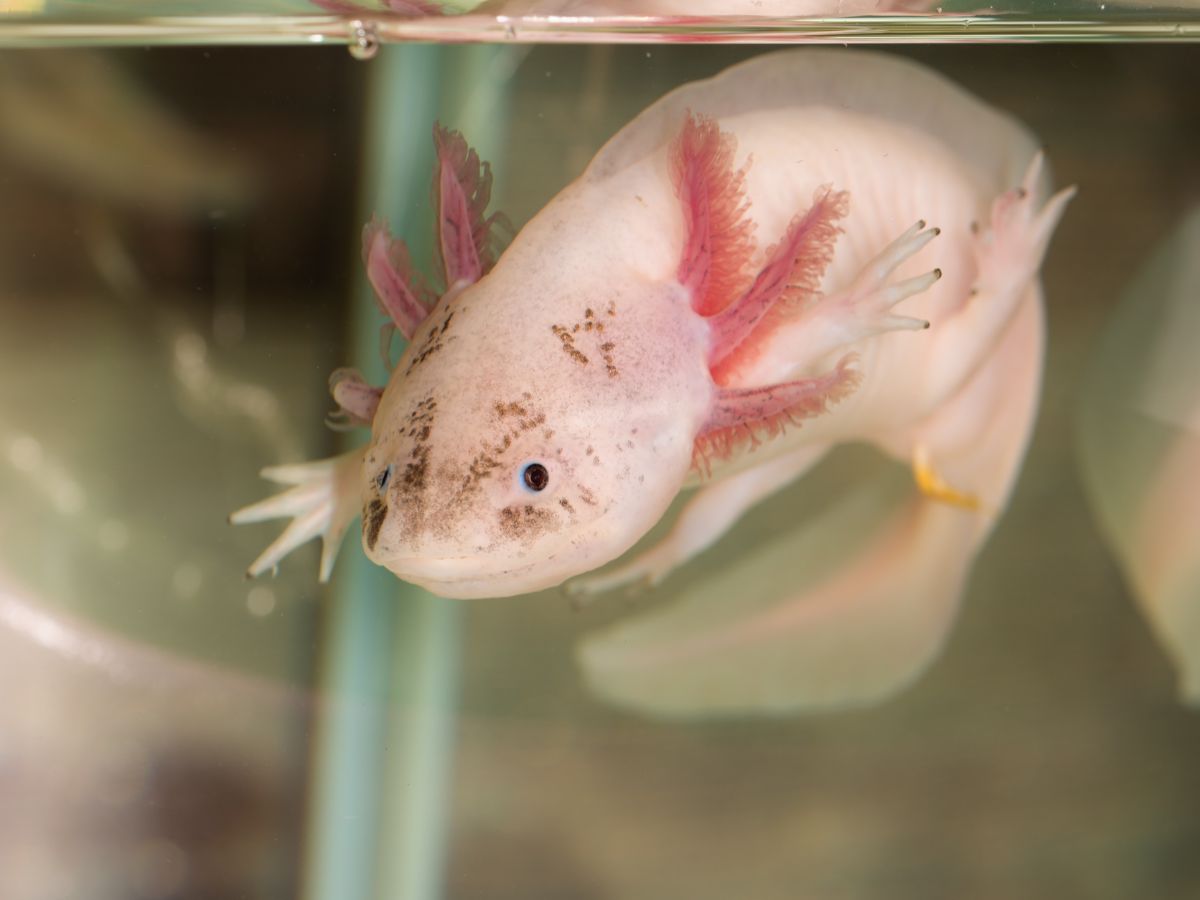You have probably seen pictures of white, dark and spotted axolotls. But how are these color morphs created and how many exist?
Axolotls come in many different colors and patterns, from light albinos with red eyes to dark melanoid axolotls. The different colors are created by chromatophores, which are located in the skin of the axolotl and store colored pigments.
Also, there are a few very rare color morphs, such as Enigma and FireFly axolotl.
Where do the different axolotl colors come from?
Wild axolotls usually have a dark color, like black, brown or grayish. All other colors are mutations and have been bred. Sometimes other species have been crossbred for this purpose, such as tiger salamanders, to create albino axolotls.
Basically, axolotls have three types of pigment-containing cells, called chromatophores, which give the axolotl skin its individual coloration:
- Melanophores contain the pigment melanin and provide dark colors
- Iridophores contain guanine crystals and look shiny white-silver
- Xanthophores contain the pigments carotenoids and pterins and provide yellow, orange and reddish colors.
What axolotl colors exist?
Over the many years that axolotls have been kept, there have been numerous different color morphs bred.
1. Wild type Axolotl
Wild type Axolotl have a gray to black base color, and their gills and eyes are usually dark colored as well. They have all three types of color cells and often have interesting patterns or spots.

2. White/ Leucistic Axolotl
Leucistic Axolotl, as the name suggests, have a white base color and dark eyes, unlike albinos. Over their body they often have darker spots. This morph is one of the most common.

3. Harlequin Axolotl
Harlequin axolotls are a special form of the leucistics. Like them, they also have a white base color, but have large pigmented spots on their head area. This often gives them the appearance of having a mask over their face.

4. Melanoid Axolotl
Melanoid axolotls are very dark, with a black or brown base coloration. Their gills are also dark to black in color. Melanoid axolotls look very similar to wildlings, but compared to them, they are darker and don’t have different colored patterns, like golden spots or something similar on their skin.

5. Axanthic Axolotl
Axanthic axolotls have a dark base color and bright, shiny spots on their skin, as they also have iridophores.

6. Gold Albino Axolotl
Gold albino Axolotl have a whitish to yellow base color with red gills. They lack the dark pigments, but also possess iridophores that produce bright, shiny spots. This axolotl color morph was originally created by crossbreeding Axolotls with tiger salamanders.

7. Albino Axolotl
These axolotls are entirely white, with red eyes and gills; they have little or no colored pigment.

8. Axanthic albino Axolotl
Axanthic albino Axolotl are pale yellow, with red eyes and gills. They often possess a metallic shimmer.
9. Copper Axolotl
Copper axolotls have a coppery base color, with light and dark spots. This color morph is relatively rare and also has red gills similar to the albino axolotl.

Depending on how you categorize the color varieties of axolotls, there may be more color morphs as well, but the above ones are the colors that are most common. However, there are also morphs that are extremely rare.
Which Axolotl color morph is the rarest?
In addition to the morphs that are frequently seen, there are a few color morphs that are rare to extremely rare.
10. Chimaera Axolotl
Chimera Axolotls are “split” in the middle of their body. The different halves of the body can have completely different colorations and patterns. Chimera axolotls rarely occur.
11. Mosaic Axolotl
Mosaic axolotls have two distinct color patterns that alternate in patches over their entire body. These animals look particularly impressive when one pattern has a light base color and the other has a dark base color.
Mosaic Axolotls, like Chimaera Axolotls, can also develop naturally, but are rarely seen.
12. Lavender Axolotl
Lavender Axolotls have a grayish-white base color that is slightly purple. In addition, they have brown or dark spots all over their body and red gills. This color variation is relatively rare.
13. Enigma Axolotl
Enigma Axolotls are a very rare color morph and are only bred in the USA. They have a dark gray base coloration and shiny golden spots all over the body. This comes from a large number of iridophores, pigmented cells with crystallized purines that provide the golden shimmer.
14. FireFly Axolotl
FireFly axolotls are extremely rare, they can’t occur naturally, they are only created for research purposes. FireFly axolotls have a tail that is a different color because it originally came from another axolotl.
To create a FireFly axolotl, the tails of axolotls are swapped during their embryo stage. Due to the fact that these axolotls are only created for research, there are extremely few of them.
Conclusion
Wild axolotls have dark colors so they can better hide from their predators. Our pet axolotls, on the other hand, come in many different color varieties and patterns. Especially rare color morphs are Enigma and FireFly axolotl.

